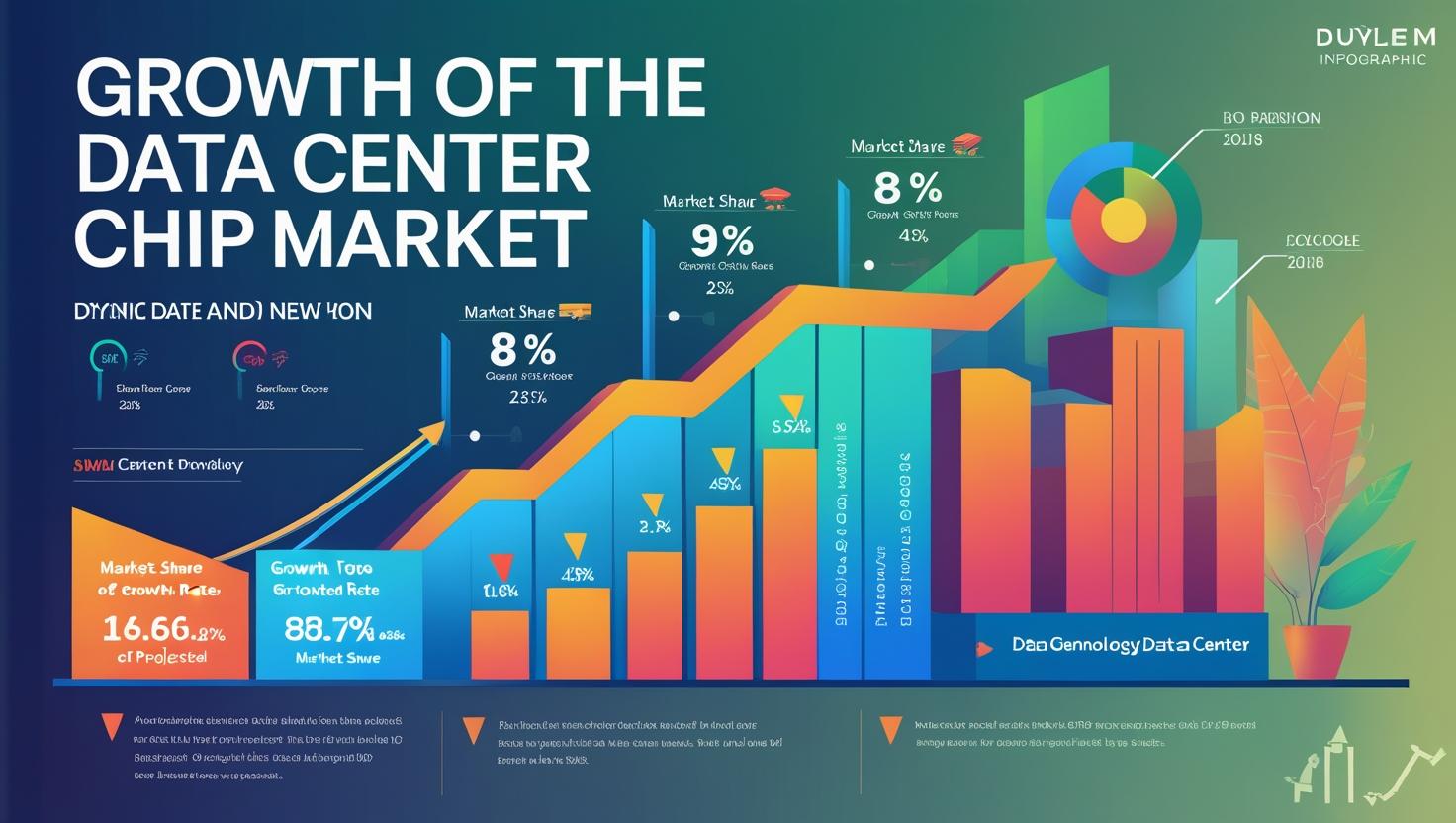The data center chip market is entering a period of unprecedented growth, driven by the explosive expansion of AI workloads, cloud computing, and hyperscale data center deployments. As demand for high-speed processing, real-time data analytics, and energy efficiency intensifies, chipmakers are racing to deliver next-generation silicon solutions that can power tomorrow’s digital infrastructure.
The global data center chip industry is expected to grow from USD 206.96 billion in 2025 to USD 390.65 billion by 2030, growing at a CAGR of 13.5% from 2025 to 2030. This rapid growth reflects the market’s pivotal role in enabling AI, machine learning, cloud services, 5G, and edge computing.
Why Data Center Chips Are More Critical Than Ever
Data center chips—ranging from CPUs and GPUs to FPGAs, TPUs, and custom ASICs—serve as the computational backbone of modern data centers. They perform the core tasks of data processing, encryption, storage management, and application delivery. With AI models becoming more complex and cloud applications more data-intensive, demand for high-performance, low-power chips is rising sharply.
Key players are innovating across multiple fronts: enhancing energy efficiency, increasing data throughput, and building custom chips optimized for specialized tasks like AI training, inferencing, or video transcoding. This technological evolution is not only driving market growth but also redefining competition among semiconductor firms and cloud service providers.
Latest Trends Shaping the Data Center Chip Market
Several key trends are fueling momentum in the data center chip ecosystem:
1. AI and ML-Specific Chip Architectures
Artificial Intelligence has become a core workload for modern data centers. As a result, companies are designing chips specifically optimized for deep learning and neural network processing. From NVIDIA’s H100 GPUs to Google’s TPUs, these AI-accelerated chips are now essential for training large models and performing real-time inferencing.
2. Rise of Custom Silicon by Cloud Providers
Major hyperscalers like Amazon (Graviton), Google (TPU), and Microsoft (Athena) are investing in in-house chip development to reduce dependence on third-party chipmakers and optimize performance for their specific workloads. This trend is driving both innovation and market fragmentation.
3. Energy Efficiency and Sustainability Focus
As data centers consume vast amounts of power, there is increasing pressure to deploy chips that balance performance with energy efficiency. Low-power ARM-based processors, intelligent cooling systems, and chip-level power management features are becoming critical differentiators.
Download PDF Brochure @ https://www.marketsandmarkets.com/pdfdownloadNew.asp?id=39999570

4. Edge Data Centers Driving New Chip Requirements
Edge computing—bringing data processing closer to the source—is creating demand for compact, ruggedized chips capable of operating in decentralized environments. These edge chips must support AI, real-time analytics, and low-latency communication, all within constrained power and space limits.
5. The x86 vs. ARM vs. RISC-V Race
While x86 remains dominant in the data center, ARM-based chips are rapidly gaining ground due to their performance-per-watt advantage. Meanwhile, RISC-V, an open-source alternative, is starting to emerge as a viable contender in highly customized and cost-sensitive deployments.
Top Companies Leading the Data Center Chip Market
The market is highly competitive, with both established giants and innovative startups pushing the boundaries of chip performance:
-
Intel Corporation remains a major player with its Xeon CPUs and expanding AI-focused product line.
-
NVIDIA dominates in GPU-based acceleration and is a key supplier for AI and HPC workloads.
-
AMD continues to gain market share with its EPYC server processors, known for high core density and energy efficiency.
-
Amazon Web Services (AWS) has developed its Graviton series of ARM-based chips, optimized for cloud-native workloads.
-
Google Cloud leverages its custom Tensor Processing Units (TPUs) for AI applications at scale.
-
Broadcom, Marvell, and Xilinx (now AMD) provide high-performance networking and FPGA-based solutions for data center acceleration.
-
Emerging players like Graphcore and Cerebras are introducing AI-focused chips that break traditional processing models.
Data Center Chip Market Outlook
Looking ahead, the data center chip market is expected to benefit from continued investments in AI infrastructure, 5G deployment, and digital transformation initiatives across industries. Enterprises are modernizing their IT infrastructure and moving workloads to the cloud, increasing demand for optimized, scalable silicon solutions.
Moreover, geopolitical factors—such as semiconductor supply chain concerns and national chip strategies—are pushing governments and corporations to prioritize innovation and resilience in chip design and production. This macro-level urgency will likely accelerate market growth and fuel next-gen research in photonic chips, neuromorphic computing, and quantum processors.
The data center chip industry is not just expanding—it’s evolving. As cloud and AI continue to redefine the digital economy, the demand for powerful, efficient, and intelligent chips will only intensify. With innovation happening at every level—from architecture and packaging to workload-specific optimization—the companies leading in this space will shape the infrastructure of the future.
For tech vendors, hyperscalers, and investors alike, the message is clear: now is the time to double down on data center silicon innovation.
Data Center Chip Market – FAQs
1. What is the data center chip market?
The data center chip market refers to the global industry surrounding the development, manufacturing, and deployment of semiconductor chips—such as CPUs, GPUs, FPGAs, TPUs, and ASICs—used in data centers to perform high-performance computing, AI processing, storage management, and networking functions.
2. What is driving the growth of the data center chip market?
Key drivers include the exponential rise in AI and machine learning workloads, rapid cloud computing adoption, growth in edge computing, and the increasing need for high-performance and energy-efficient infrastructure to support real-time data processing and storage.
3. What is the current market size and growth forecast?
The global data center chip industry is expected to grow from USD 206.96 billion in 2025 to USD 390.65 billion by 2030, growing at a CAGR of 13.5% from 2025 to 2030.
